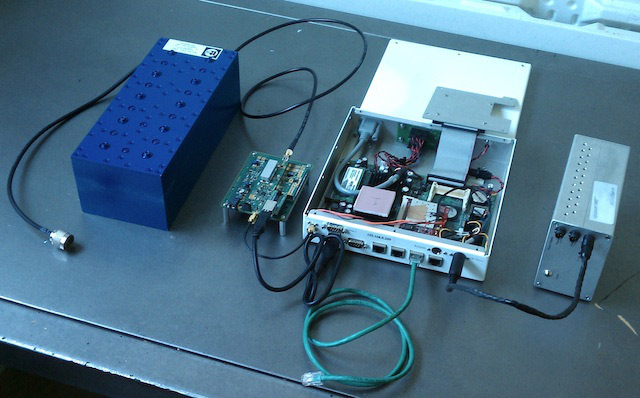Broadcast WiFi on empty TV frequencies

From left to right: VHF filter, converter, PC motherboard and WiFi card, power supply
American student Ryan Guerra built a working device to broadcast WiFi signal over a distance of more than 1600 m. The
home-made design (in the photo above) consists of a standard a WiFi card, a Linux computer, and an experimental Alcatel Lucent converter that lowers the frequency from 2.4 GHz (20 MHz channel width) to 563 MHz (unused TV channel, 5 MHz width). At the output of the converter, a regular TV antenna is connected, which can be installed outside the house.

The beam width of this antenna is about 60 ° in the horizontal plane, so that anyone who falls into this sector can receive the signal. Since the channel narrowed fourfold from 20 MHz to 5 MHz, the data transfer rate is proportionally reduced, which is natural.
As experience has shown, lowering the frequency provides better signal reception in conditions of poor visibility, for example, through dense foliage of trees. In real conditions, the signal was successfully broadcast over a mile (1609 m), although there was no direct line of sight.
Of course, for the technology to work, a similar home-made design must be on the transmission side, and on the receiving side. This may be necessary if your house is a kilometer from the free hotspot, but you still want to work with WiFi. Then you can put the transmitter in the hotspot zone and receive the signal from a long distance.
It should be noted that Ryan Guerra is not a simple student, but a member of the university research group, which last year won a grant of the US National Science Society in the amount of $ 1.8 million for the development of broadband data transfer technologies in unused areas between TV channels ( white spaces )
This is not the first attempt to use telecom frequencies for data transmission. For example, a year and a half ago, in the small American town of Claudeville (Virginia), an urban network was created on unused television frequencies, which is considered the first such project in urban environments. There were other small experiments: for example, the same “lokalka” was tested on the Microsoft campus.
In such a system, the most difficult is the coordination of frequencies of all transmitting devices so that they do not interfere with each other. If you use the native Carrier Sense Multiple Access (CSMA) Wi-Fi standard, then with a large number of devices network bandwidth will significantly decrease. Perhaps, for “WiFi on steroids” you will have to introduce new protocols (by the way, Microsoft has been working on this for a long time).
